Brownie (camera)
The Brownie was a long-running popular series of simple and inexpensive cameras made by Eastman Kodak. Introduced in 1900,[1] it introduced the snapshot to the masses. It was a basic cardboard box camera with a simple meniscus lens that took 2 1/4-inch square pictures on 117 roll film. It was conceived and marketed for sales of Kodak roll films. Because of its simple controls and initial price of $1 (equivalent to $31 in 2019) along with the low price of Kodak roll film and processing, the Brownie camera surpassed its marketing goal[2]
.jpg) Brownie 2 | |
| Overview | |
|---|---|
| Maker | Eastman Kodak |
| Type | box camera |
| Lens | |
| Lens | meniscus lens |
| Sensor/medium | |
| Film format | 117 roll film. |
| Film size | 2 1/4-inch square |
| Shutter | |
| Shutter | Integrated |
| General | |
| Body composition or special features | Leatherette covered cardboard |
| List price | $1 (equivalent to $31 in 2019) |
| Made in | Rochester, NY |
| Chronology | |
| Released | February 1900 |
| Production | Feb. 1900-Oct. 1901 |
| Successor | No. 2 Brownie (1901) |
| References | |
| Brownie (original model) | |
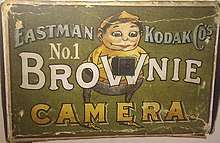
It was invented by Frank A. Brownell.[3] The name comes from the brownies (spirits in folklore) in Palmer Cox cartoons. Over 150,000 Brownie cameras were shipped in the first year of production.[4] An improved model, called No. 2 Brownie came in 1901, which produced larger 2-1/4 by 3-1/4 inch photos and cost $2 and was also a huge success.[2]
Brownies were extensively marketed to children, with Kodak using them to popularise photography. They were also taken to war by soldiers. As they were ubiquitous, many iconic shots were taken on Brownies.[2]
The cameras continued to be popular, and spawned many varieties, such as a Boy Scout edition in the 1930s. In 1940, Kodak released the Six-20 Flash Brownie,[4] Kodak's first internally synchronized flash camera, using General Electric bulbs. In 1957, Kodak produced the Brownie Starflash, Kodak's first camera with a built-in flash.[4]
The Brownie 127 was popular,[5] selling in the millions between 1952 and 1967. It was a bakelite camera with a simple meniscus lens and a curved film plane to compensate for the deficiencies of the lens. Another model was the Brownie Cresta sold between 1955 and 1958. It used 120 film and had a fixed-focus lens.
Having written an article in the 1940s for amateur photographers suggesting an expensive camera was unnecessary for quality photography, Picture Post photographer Bert Hardy used a Brownie camera to stage a carefully posed snapshot of two young women sitting on railings above a breezy Blackpool promenade.[6]
The last official Brownie camera made was the Brownie II Camera, a 110 cartridge film model produced in Brazil for one year, 1986.
The Kodak Brownie Number 2 is a box camera that was manufactured by the Eastman Kodak Company from 1901 to 1935.[4] There were five models, A through F, and it was the first camera to use 120 film. It also came with a viewfinder and a handle.[7] The Brownie Number 2 was made of a choice of three materials: cardboard, costing US$2.00, aluminum, costing US$2.75, and a color model which cost US$2.50. It was a very popular and affordable camera, and many are still in use by film photographers.
Gallery
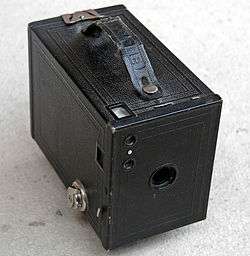 Brownie No. 2 (1901–35)
Brownie No. 2 (1901–35) No. 2 Folding Autographic Brownie 1915–26)
No. 2 Folding Autographic Brownie 1915–26)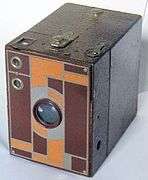 Beau Brownie camera (1930–33)
Beau Brownie camera (1930–33)- Hawkeye Brownie Flash Model (1950–61)
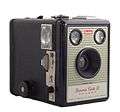 Brownie Flash III (1957–60)
Brownie Flash III (1957–60)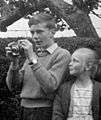 Young photographer using a Brownie 127
Young photographer using a Brownie 127
References
- List of Brownie models at George Eastman House Archived April 2, 2016, at the Wayback Machine
- Lothrop, Eaton S. “The Brownie Camera.” History of Photography 2, no. 1 (January 1978): 1–10. https://doi.org/10.1080/03087298.1978.10442948.
- U.S. Patent 725,034
- Gustavson, Todd (2011). 500 Cameras 170 years of photographic innovation. Sterling Signature. ISBN 978-1-4027-8086-8.
- "Brownie 127"
- Bert Hardy snapshot
- Gustavson, Todd (2009). Camera A history of photography from Daguerreotype to Digital. Sterling Signature. ISBN 978-1-4027-5656-6.
Further reading
- Dowling, Stephen (5 January 2015). "The most important cardboard box ever?". Retrieved 5 January 2014., gives history of the Brownie camera line
External links
| Wikimedia Commons has media related to Kodak Brownie. |
- U.S. Patent 725,034 Kodak Brownie, patented by Frank Brownell, filed July 1900
- The Brownie Camera @ 100: A Celebration on the Kodak website
- Kodak Brownie Target Six-20: A Review